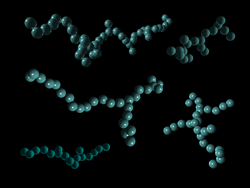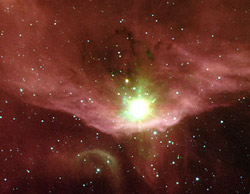Sowing the Seeds of Planets

Planet Earth began 4.6 billion years ago as humble specks of dust that stuck together within a disk around our newborn sun. A dust experiment aboard a rocket suggests that those specks first assembled into elongated chains of particles, rather than the clumpier structures that some computer simulations had predicted. The results, published in the 9 July PRL, confirm some earlier, more limited findings about fluffy “planetary seedlings” but also include new types of measurements.
In computer simulations of the earliest stages of a planet’s growth, particles floating within a gaseous disk collide because of their constant thermal agitation, known as Brownian motion. Gravitational attraction is negligible for tiny dust grains, so they stick only through electrostatic van der Waals forces. The simulations predict loose aggregates of particles with many branches in a complex network, like a portion of a spider’s web. Mathematically, such branched chains have a so-called fractal dimension of just under 2, midway between a linear string of fractal dimension 1.0 and a compact yet porous clump of dimension 3.0. But checking this prediction isn’t easy because it requires low gravity.

In 1998 a team led by Jürgen Blum of the Technical University in Braunschweig, Germany, tested the simulation predictions in an enclosed experiment on a space shuttle flight. The team released a cloud of silicon-dioxide dust particles–in essence, micron-sized glass spheres–and took photographs with microscopes as the particles interacted. The results [1] hinted that the dusty structures were unexpectedly open, consisting of long chains with few branched sections and no clumps. But the particles quickly drifted to the side of the canister, limiting the data.
The new results come from an adapted version of the same experiment, launched aboard an unmanned rocket from northern Sweden in 1999. The rocket’s dusty cargo was in microgravity for 6 minutes. Blum and colleague Maya Krause of Friedrich Schiller University in Jena, Germany, designed high-speed microscopes that scanned across the cloud of silicate spheres as they floated through the brightly lit container. As the particles stuck together and grew, they produced increasingly darker silhouettes against the lighted background. Krause and Blum determined the masses of the aggregates from the amount of light they absorbed. Then, they deduced the structures’ shapes from the sizes of the blotches in the images: tiny black spots for tight clumps, or extended smudges for long strings.
The results confirm the tentative findings from the shuttle flight, Blum says. Dust aggregates had a typical fractal dimension of 1.4, pointing to long chains of silicate spheres with few side branches. “No one has managed to model this extreme fluffiness from first principles,” Blum says. He suspects that the Brownian motions of the growing dust chains make them rotate quickly every few milliseconds, like tiny helicopter blades. Most new dust particles would then get swept up by the ends of the chains before they have a chance to adhere to particles in the middle. The research also went beyond the space shuttle data to show that the dust structures grew at an exponentially increasing rate–so quickly, says Blum, that aggregates of 100 grains or more should be common within one year of the formation of a disk around a new star.
The new report should help astronomers interpret how large dust grains affect images of planet-forming regions from NASA’s new Spitzer Space Telescope, which uses infrared light to peer into star-forming clouds, says theorist Stuart Weidenschilling of the Planetary Science Institute in Tucson, Arizona. “It’s an ingenious experiment,” he says. However, Weidenschilling adds that Blum and others still must demonstrate whether the same mechanism can assemble planet-building clumps more than a meter wide.
–Robert Irion
Robert Irion is a freelance science writer based in Santa Cruz, CA.
References
- J. Blum et al., “Growth and Form of Planetary Seedlings: Results from a Microgravity Aggregation Experiment,” Phys. Rev. Lett. 85, 2426 (2000)


